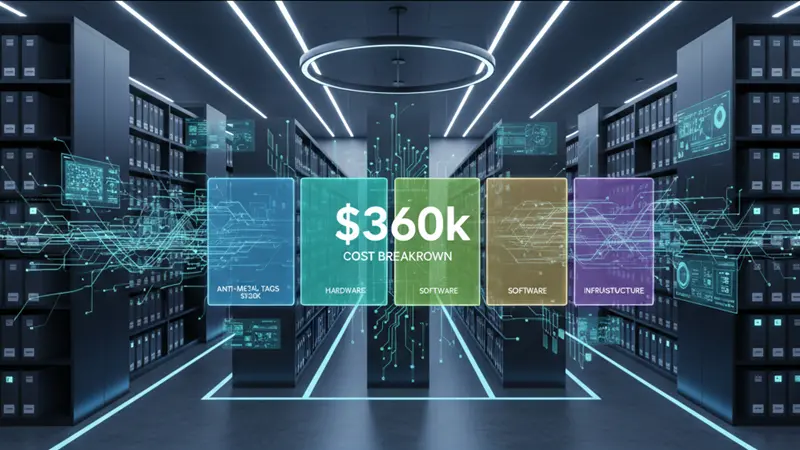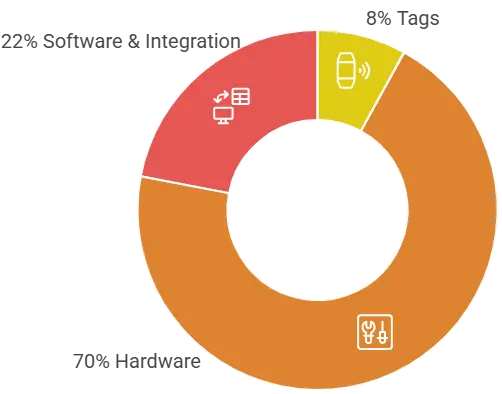
How Much Does an RFID System Really Cost? A Breakdown of a $360k Tender
Custom Your RFID Cards
When organizations look to deploy an RFID-based intelligent asset management system, one of the first questions on their minds is straightforward: “What’s the actual cost of a full RFID solution?”
Unfortunately, most pricing info available online is fragmented and short on real-world context, leaving decision-makers without reliable benchmarks to guide their choices. That’s what makes a recent public tender (over $360,000) such a valuable resource: it offers an unusually transparent breakdown of the cost structure behind a full-scale, RFID-enabled smart archive warehouse.

This project doesn’t just focus on one function; it integrates intelligent shelving, RFID asset tracking, environmental monitoring, and security systems into a single connected ecosystem. For any enterprise gearing up to digitize its asset management processes, this case delivers actionable, real-world insights.
Why This Project Matters
This is not an ordinary RFID deployment. It serves an organization managing over 100,000 archive files , stored in a dense metal compact-shelving environment , one of the most challenging conditions for RFID due to reflection, signal interference, and limited space.
The project’s goal wasn’t just to “read tags,” but to achieve:
- Precise item-level tracking of every archive box
- Real-time monitoring of asset movement and status
- Seamless integration with shelving, security, and fire control systems
In other words, it represents the real-world complexity that many enterprises face when upgrading to intelligent archival management. That makes it the perfect model for understanding what drives RFID system costs in complex environments.
Where the Budget Goes: Inside the RFID Cost Breakdown
A mature RFID system typically includes three key layers:
(1) Tags (2) Hardware (3) Software and Integration
1. RFID Tags — The Digital ID of Every Archive
Archive RFID Tags (99,100 pcs)
- Frequency: 920–925 MHz (EPCGlobal C1G2 / ISO18000-6C compliant)
- Printable with archive ID and metadata
- Read range ≥ 2 m, lifetime > 10 years
- Approximate unit cost: $0.17
These adhesive RFID tags are affixed to archive boxes to serve as their unique digital identity, enabling rapid and accurate bulk inventory checks.
Shelf Tags (3,700 pcs)
- Designed for metal shelves, read range ≥ 10 cm
- Material: clear acrylic + 3M industrial adhesive
- Printable with storage location codes
- Approximate unit cost: $0.67
In dense metal environments, such anti-metal RFID tags are not optional, they are the foundation for stable system performance.
2. RFID Hardware — The Physical Infrastructure
Hardware represents the largest investment, forming the sensor network that connects every part of the system.
| Device | Quantity | Highlights |
|---|---|---|
| RFID Inventory Cart | 3 units | 21.5″ touch display, SSD mainboard, 60Ah lithium battery; supports automatic shelf opening and bulk scanning; 8-hour operation. |
| Workstation Terminals | 3 units | Integrated reader/writer module for registration, lending, and label printing; >99% write success rate. |
| Handheld Terminals | 3 units | Reads 200+ tags/sec, IP65-rated, supports Wi-Fi/Bluetooth, GPS-enabled for location logging. |
| RFID Gate Systems | 4 sets | 10.1″ display, sound/light alarms; detects unauthorized archive movement and logs personnel traffic. |
Together, these devices enable full lifecycle traceability, from archive entry to exit, inventory scanning, and security verification.
3. RFID Management Software — The Digital Brain
The project uses a browser/server (B/S) architecture RFID management platform, integrating five key functions:
- Full lifecycle archive management
- Precise positioning & automatic shelving control
- Smart inventory and statistical reporting
- Permission-based access & audit logs
- System integration with security and fire systems
Though often underestimated, this software layer determines the scalability, interoperability, and automation capability of the entire system.
4. Cost Distribution Summary
From the bid documents, the approximate budget allocation is as follows:
- Tags: ~8%
- Hardware: ~70%
- Software & Integration: ~22%

This ratio is widely considered typical for large-scale RFID archive management projects and serves as a reliable reference point for budget planning.
Three Key Insights for Future RFID Projects
1. Success Depends on Architecture, Not Tag Prices
The cost of individual RFID tags has little impact on project success. The system architecture, hardware layout, and radio frequency design are what ultimately determine stability and ROI.
2. Environmental Adaptation Defines ROI
In metallic or high-density environments, cutting corners on anti-metal RFID tags or reader quality often leads to signal failures and inaccurate reads—causing far greater losses than the savings.
3. The True Value of RFID Goes Beyond Efficiency
A well-designed RFID system delivers:
- Over 10× faster inventory speed
- Full traceability of every document or asset
- Higher space utilization through intelligent storage optimization
These long-term benefits far outweigh the initial hardware investment.
Conclusion: Making RFID Investment Transparent
This $360,000 smart archive tender reveals a fundamental truth:
An RFID project isn’t just a collection of hardware—it’s a synchronized ecosystem of technology, environment design, and integration strategy.
Understanding the cost structure helps organizations plan smarter, invest more confidently, and transform uncertainty into measurable efficiency.


